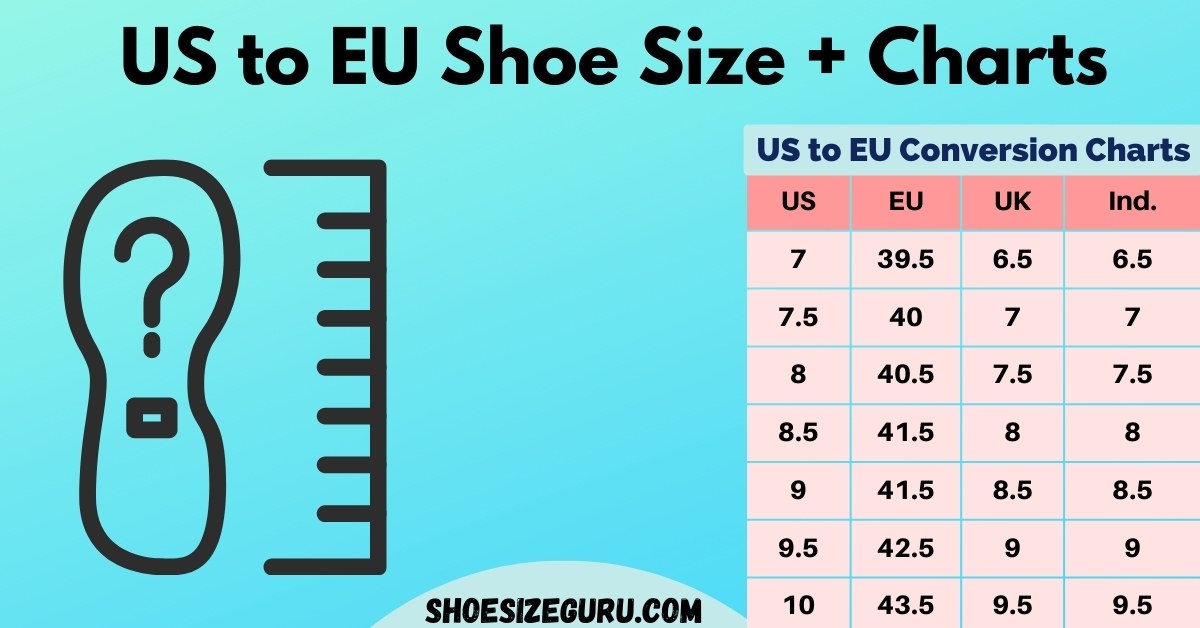Have you been looking to convert your US shoe size to EU or EU shoe size to US? If YES! You have landed on the right page.
When it comes to shopping for shoes, getting the perfect fit is like finding a treasure. Isn’t it?
Whether you’re browsing online or trying on shoes in a store, understanding how to convert US shoe sizes to EU sizes can save you from the frustration of ordering the wrong fit shoe.
In this comprehensive guide, you will learn how shoe sizes work in the US and Europe, the difference between US and EU shoe sizes, the EU shoe sizing standards, the US footwear sizing pattern, and everything you need to know about European shoe size to US.
Being shoesizeguru, I always say shoe sizes are the language spoken by different countries.
Shoesizeguru.com
In addition, I will also cover the comparison between European and US shoe sizes and provide you with a guide to determining your foot size at home using a few straightforward steps.
Before we start converting shoe sizes, let’s understand the US and EU shoe sizing patterns & how European shoe sizes compare to the US.
Understanding US Shoe Sizes
US shoe sizing system uses inches in their measurement and the scale is determined with the help of barleycorn. Barleycorn is also known as an Old English unit for shoe size measurement. The length of one Barleycorn is 0.26 inches or 2/3 centimeters (source).
The largest shoe size in the US is size 12 which is equivalent to 30.5 cm or 12 inches. The counting for US shoe size is also backward which is done with substracting one barleycorn. So 12 inches minus 1 Barleycorn or 1/3 inch is equal to 11.67 inches.
Women, Men, and kids in the US also have their own sizing to get accurate sizes for each type of people. US women go 1.5 or 2 sizes larger than US men to get the same length. For instance, if you wear a US women’s size 8 then it will be Men’s size 6 or 6.5.
Understanding EU Shoe Sizes
EU or European shoe sizing system is considered to be the most rational sizing system. If we can compare the complexity of all sizing systems, the EU will probably be the least complicated one. As a result, people who want to know their EU shoe size can simply measure their feet and figure out their size even without using a size chart. However, it is always recommended to use a footwear size chart if you have it.
The unit of measurement for shoes in the EU region is the Paris Point. It is a unique measurement commonly used in Continental Europe. This sizing system started in the early 1800s when a French shoemaker invented it.
The length of one Paris Point is 2/3 centimeters or 6/67 millimeters. So if your UK size is 45 then your foot length will be 2/3 cm x 45. In regard to the previous equation, there is a simple formula to determine your EU shoe sizes. The formula is 1.5 x Length of Foot in cm + 1.5.
By using this formula, you can find your EU shoe size. If your foot length is 27 cm then add 1.5 to it, making it 28.5 cm. Now multiply 28.5 cm by 1.5 and your EU size is 42. Since everyone has different shapes of foot, you should always consider going one size up.
How do European Shoe Sizes Compare to the US?
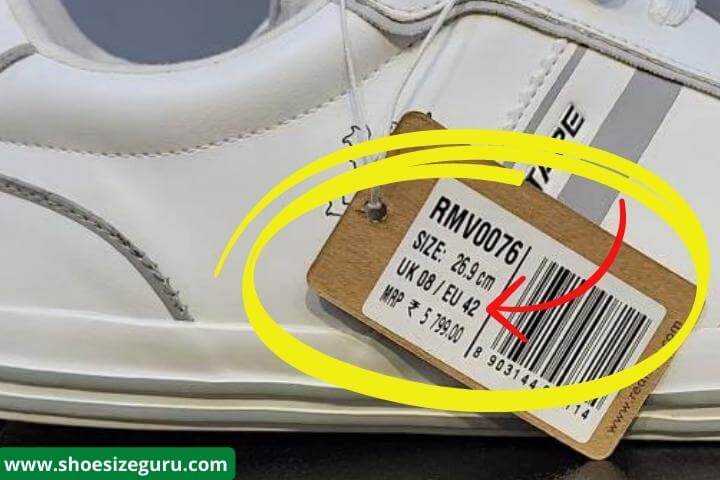
The shoe size measurements differ across countries in our modern world. The United States, Europe, and the United Kingdom each use their unique shoe measurement system, it’s a bit like having special rulers for shoes!
Europeans have a different system than Americans when it comes to shoe sizes. The length of the foot in centimeters is the basis for European sizing. For men’s shoes, for instance, a size 40 in Europe generally translates to a size 9 in the US. This isn’t a general rule though, as different brands may have different size conversions.
You know how when you bake cookies, you might use cups to measure flour, but in another kitchen, they might use a scale to measure grams? Well, it’s kinda like that with shoes too!
Are you still confused? check out this US to EU Shoe Size Chart!
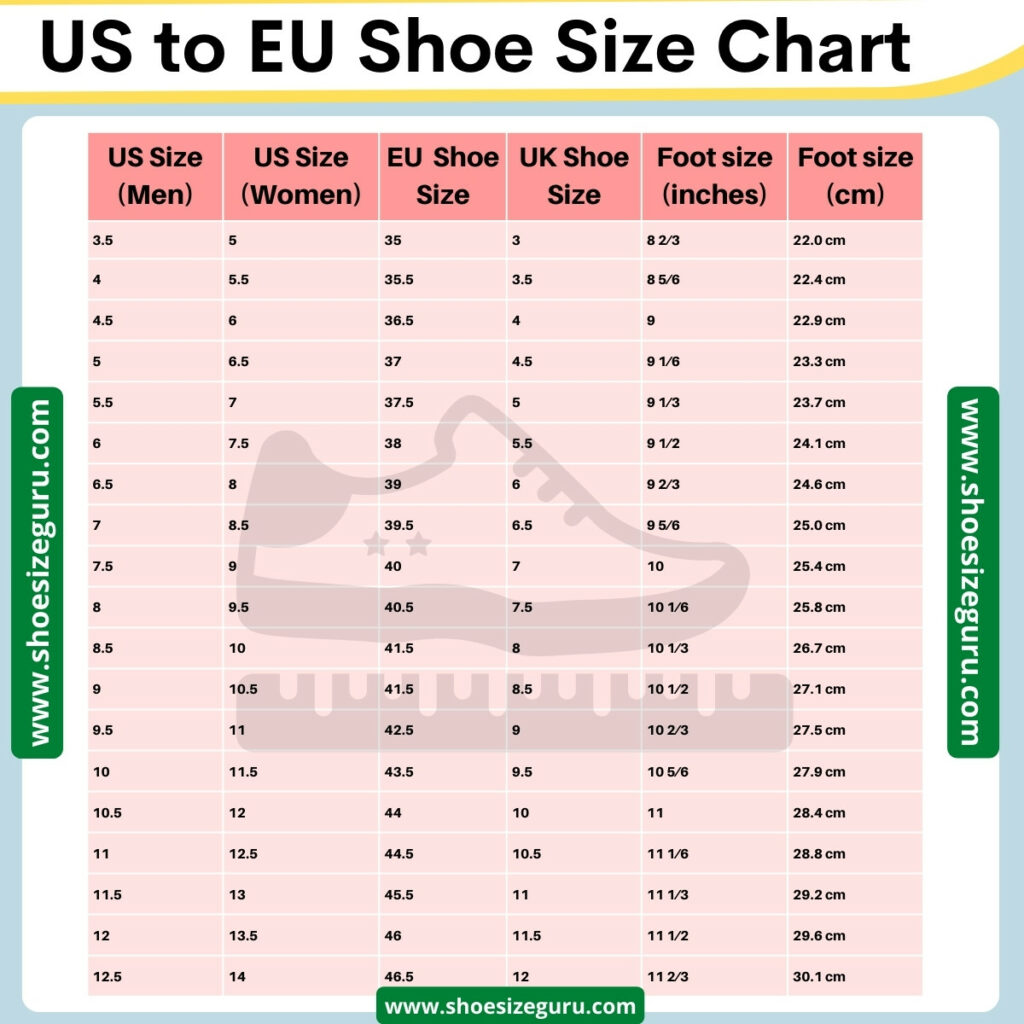
Note: European (EU) shoe sizes are unisex, making men’s and women's shoe sizes the same. When it comes to the US, sizes differ by gender. So, it’s crucial to check the universal US shoe size conversion chart to EU counterparts.
European Shoe Size to US Conversion Chart for Men & Women
The given shoe conversion chart shows the international European shoe size to the US conversion chart for both men and women.
| EU Sizes | US Men’s Sizes | US Women’s Sizes | UK Sizes | Foot Length (cm) | Foot Length (Inches) |
|---|---|---|---|---|---|
| 34.5 | 3 | 4.5 | 2.5 | 21.6 cm | 8 1/2 |
| 35 | 3.5 | 5 | 3 | 22.0 cm | 8 2/3 |
| 35.5 | 4 | 5.5 | 3.5 | 22.4 cm | 8 5/6 |
| 36.5 | 4.5 | 6 | 4 | 22.9 cm | 9 |
| 37 | 5 | 6.5 | 4.5 | 23.3 cm | 9 1/6 |
| 37.5 | 5.5 | 7 | 5 | 23.7 cm | 9 1/3 |
| 38 | 6 | 7.5 | 5.5 | 24.1 cm | 9 1/2 |
| 39 | 6.5 | 8 | 6 | 24.6 cm | 9 2/3 |
| 39.5 | 7 | 8.5 | 6.5 | 25.0 cm | 9 5/6 |
| 40 | 7.5 | 9 | 7 | 25.4 cm | 10 |
| 40.5 | 8 | 9.5 | 7.5 | 25.8 cm | 10 1/6 |
| 41.5 | 8.5 | 10 | 8 | 26.2 cm | 10 1/3 |
| 41.5 | 9 | 10.5 | 8.5 | 26.7 cm | 10 1/2 |
| 42.5 | 9.5 | 11 | 9 | 27.1 cm | 10 2/3 |
| 43.5 | 10 | 11.5 | 9.5 | 27.5 cm | 10 5/6 |
| 44 | 10.5 | 12 | 10 | 27.9 cm | 11 |
| 44.5 | 11 | 12.5 | 10.5 | 28.4 cm | 11 1/6 |
| 45.5 | 11.5 | 13 | 11 | 28.8 cm | 11 1/3 |
| 46 | 12 | 13.5 | 11.5 | 29.2 cm | 11 1/2 |
| 46.5 | 12.5 | 14 | 12 | 29.6 cm | 11 2/3 |
| 47 | 13 | 14.5 | 12.5 | 30.1 cm | 11 5/6 |
| 47.5 | 13.5 | 15 | 13 | 30.5 cm | 12 |
| 48.5 | 14 | 15.5 | 13.5 | 30.9 cm | 12 1/6 |
| 49 | 14.5 | 16 | 14 | 31.3 cm | 12 1/3 |
| 49.5 | 15 | 16.5 | 14.5 | 31.8 cm | 12 1/2 |
| 50 | 15.5 | 17 | 15 | 32.21 cm | 12 2/3 |
US to EU Shoe Size Chart Men
To convert to your European size, generally add 32 or 33 to your US men’s size. For example, if your US size is 8 then your EU shoe size will be 40 or 41. Keep in mind that, this rule is intended to give you a general idea of what is your shoe size. To get more accurate sizing, always measure your foot from the brand’s scale.
You should also refer to the given sizing chart and its guide to get a more accurate size for your foot.
| US Sizes | EU Sizes | UK Sizes | Foot Length (cm) | Foot Length (Inches) |
|---|---|---|---|---|
| 3 | 34.5 | 2.5 | 21.6 cm | 8 1/2 |
| 3.5 | 35 | 3 | 22.0 cm | 8 2/3 |
| 4 | 35.5 | 3.5 | 22.4 cm | 8 5/6 |
| 4.5 | 36.5 | 4 | 22.9 cm | 9 |
| 5 | 37 | 4.5 | 23.3 cm | 9 1/6 |
| 5.5 | 37.5 | 5 | 23.7 cm | 9 1/3 |
| 6 | 38 | 5.5 | 24.1 cm | 9 1/2 |
| 6.5 | 39 | 6 | 24.6 cm | 9 2/3 |
| 7 | 39.5 | 6.5 | 25.0 cm | 9 5/6 |
| 7.5 | 40 | 7 | 25.4 cm | 10 |
| 8 | 40.5 | 7.5 | 25.8 cm | 10 1/6 |
| 8.5 | 41.5 | 8 | 26.2 cm | 10 1/3 |
| 9 | 41.5 | 8.5 | 26.7 cm | 10 1/2 |
| 9.5 | 42.5 | 9 | 27.1 cm | 10 2/3 |
| 10 | 43.5 | 9.5 | 27.5 cm | 10 5/6 |
| 10.5 | 44 | 10 | 27.9 cm | 11 |
| 11 | 44.5 | 10.5 | 28.4 cm | 11 1/6 |
| 11.5 | 45.5 | 11 | 28.8 cm | 11 1/3 |
| 12 | 46 | 11.5 | 29.2 cm | 11 1/2 |
| 12.5 | 46.5 | 12 | 29.6 cm | 11 2/3 |
| 13 | 47 | 12.5 | 30.1 cm | 11 5/6 |
| 13.5 | 47.5 | 13 | 30.5 cm | 12 |
| 14 | 48.5 | 13.5 | 30.9 cm | 12 1/6 |
| 14.5 | 49 | 14 | 31.3 cm | 12 1/3 |
| 15 | 49.5 | 14.5 | 31.8 cm | 12 1/2 |
| 15.5 | 50 | 15 | 32.2 cm | 12 2/3 |
US Shoe Size to EU Chart Women
To get your European size in women’s shoes, add 30 to 32.5 to your US size. if you typically wear a US women’s size 8, then your EU shoe size is 41 or 42. Your size can have a half-size increment so also try half a size up when choosing your shoe size in the US or EU.
Refer to the given shoe size chart for easy conversion.
| US Sizes | EU Sizes | UK Sizes | Foot Length (cm) | Foot Length (Inches) |
|---|---|---|---|---|
| 4.5 | 34.5 | 2.5 | 21.6 cm | 8 1/2 |
| 5 | 35 | 3 | 22.0 cm | 8 2/3 |
| 5.5 | 35.5 | 3.5 | 22.4 cm | 8 5/6 |
| 6 | 36.5 | 4 | 22.9 cm | 9 |
| 6.5 | 37 | 4.5 | 23.3 cm | 9 1/6 |
| 7 | 37.5 | 5 | 23.7 cm | 9 1/3 |
| 7.5 | 38 | 5.5 | 24.1 cm | 9 1/2 |
| 8 | 39 | 6 | 24.6 cm | 9 2/3 |
| 8.5 | 39.5 | 6.5 | 25.0 cm | 9 5/6 |
| 9 | 40 | 7 | 25.4 cm | 10 |
| 9.5 | 40.5 | 7.5 | 25.8 cm | 10 1/6 |
| 10 | 41.5 | 8 | 26.2 cm | 10 1/3 |
| 10.5 | 41.5 | 8.5 | 26.7 cm | 10 1/2 |
| 11 | 42.5 | 9 | 27.1 cm | 10 2/3 |
| 11.5 | 43.5 | 9.5 | 27.5 cm | 10 5/6 |
| 12 | 44 | 10 | 27.9 cm | 11 |
| 12.5 | 44.5 | 10.5 | 28.4 cm | 11 1/6 |
| 13 | 45.5 | 11 | 28.8 cm | 11 1/3 |
| 13.5 | 46 | 11.5 | 29.2 cm | 11 1/2 |
| 14 | 46.5 | 12 | 29.6 cm | 11 2/3 |
| 14.5 | 47 | 12.5 | 30.1 cm | 11 5/6 |
| 15 | 47.5 | 13 | 30.5 cm | 12 |
| 15.5 | 48.5 | 13.5 | 30.9 cm | 12 1/6 |
| 16 | 49 | 14 | 31.3 cm | 12 1/3 |
| 16.5 | 49.5 | 14.5 | 31.8 cm | 12 1/2 |
| 17 | 50 | 15 | 32.2 cm | 12 2/3 |
Euro Shoe Size to US Kids (4 to 12 Years)
Kids’ shoe conversion is comparable. To obtain the equivalent European size for kids, add 19 to the US size. Therefore, your child’s European size would be around 24 if they wear a US size 5.
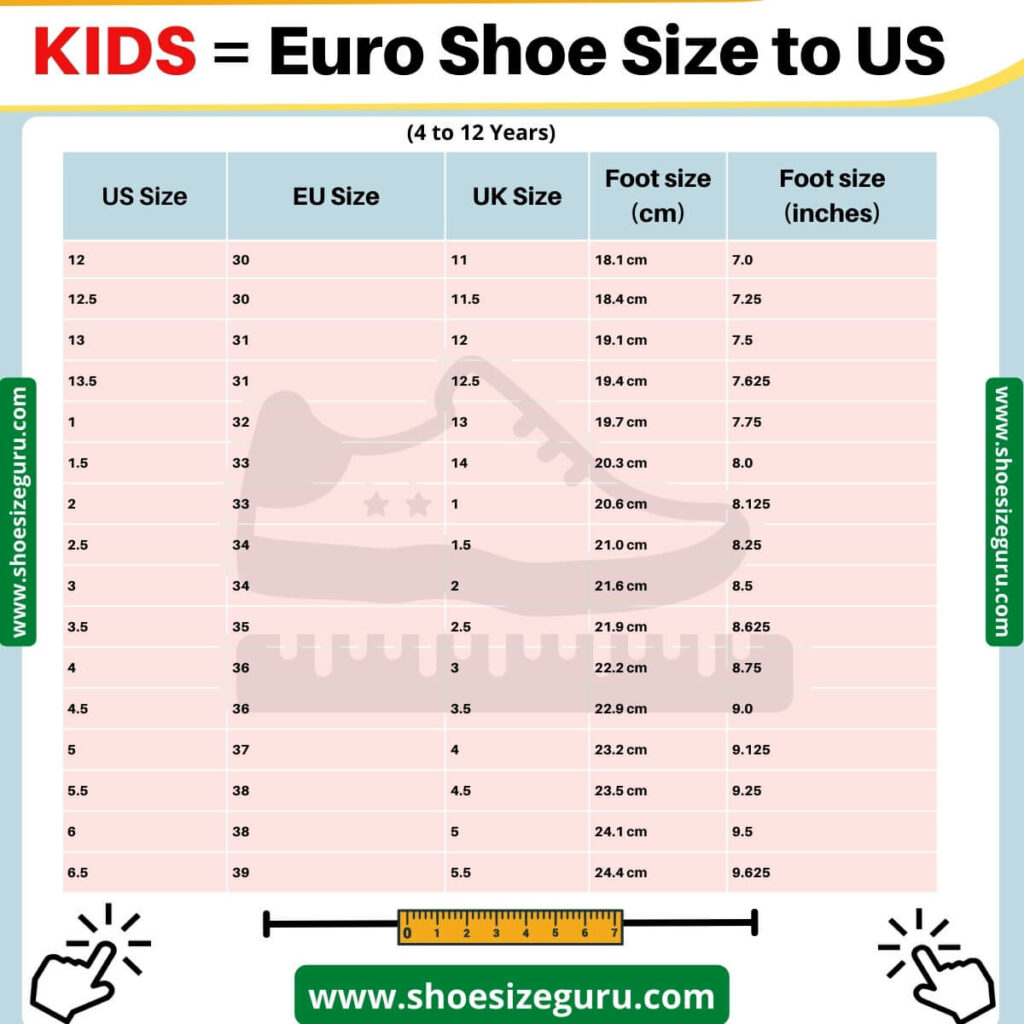
How to Convert Shoe Size from US to Europe?
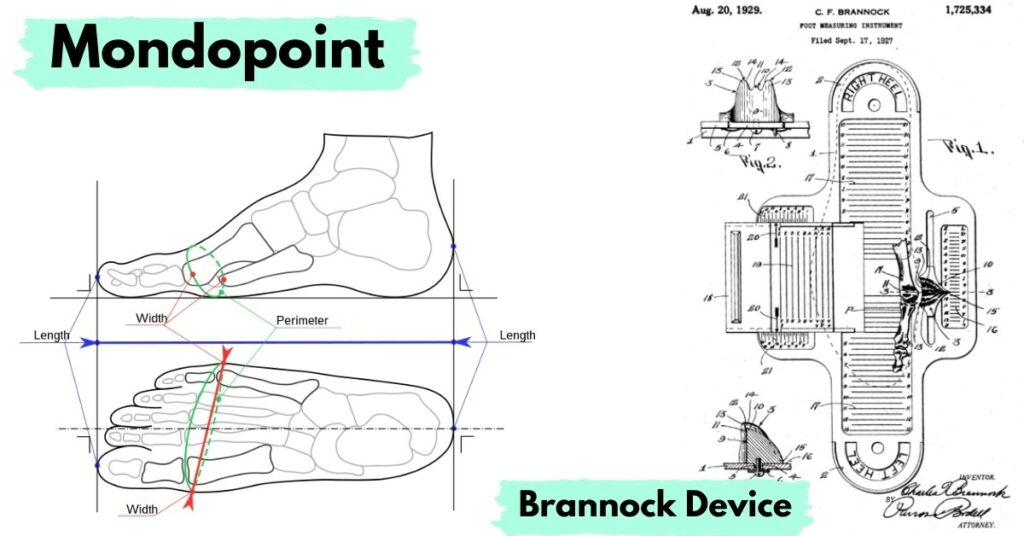
It takes a considerable amount of calculations to convert shoe sizes from the US to Europe. To find your European size, generally add 31 to your US men’s size. For US women to EU women, add 31 to 32.5 to your current US size. Keep in mind that the sizes can go one or half size up in regards to what your EU size is after the calculation.
Here are some pointers to guarantee a precise conversion:
- Refer to the brand’s size chart: Verify brand-specific guides as different brands could follow somewhat different size guidelines. If there is a size conversion chart available, always refer to it.
- Think about width: Regional differences exist in shoe width. When converting sizes, keep in mind that European shoes could fit narrower than American shoes.
- Examine reviews: If you’re shopping online, you may learn whether a specific brand’s shoes tend to run large or small by reading user reviews.
- Recognize half sizes: Half sizes are frequently available for European sizes. In the US, go with the bigger European size if you are in between two sizes.
Is US shoe size same as EU shoe size?
No, they’re not the same. While the EU uses the length of the foot in centimeters, the US uses inches. On top of that, both the US and EU use different sizing systems known as Barleycorn and Paris Point. To convert a US size to an equivalent EU size, a certain amount must be added.
Is EU shoe size same as UK?
No, even though the EU and the UK share a numerical system, their size scales are different. You must take into account the unique conversion guidelines for each when converting between the two.
Is Italian shoe size same as European?
Yes, the European size system and the Italian shoe sizing system are compatible. As a result, you may buy Italian shoes in the same size with confidence if you know your European size.
How do I Figure Out My Shoe Size?
Figuring out your shoe size is an easy process. Here’s what you can do:
- Find a piece of paper, a pencil, and a ruler.
- Put the paper on the floor, then stand up straight on the paper with your heel against a wall.
- Now, ask somebody to help you trace the outline of your foot on the paper. Make sure the pencil stays close to your foot as you go around.
- Use a ruler to measure from the back of your heel to the longest part of your toe. That’s your foot length!
- Repeat this process with your other foot and record your measurements.
- Now, it’s time to compare your foot size with the shoe size conversion chart. How to compare? Match your foot length to the right size on the chart. For example, If your foot is about 8 inches long, then you’d look for the size that matches that length.
It’s important to remember that as you grow your feet also grow with you, so it’s good to measure your feet every once in a while to make sure you’re still wearing the right size.
Are Euro Shoe Sizes Unisex?
Absolutely, Europe generally follows a unisex approach to measuring shoe sizes. In the EU shoe sizing system, shoe sizes are not divided by gender, which means that the same size number applies to both men’s and women’s shoes.
But, it’s important to remember that there might be some variations in shoe width and style among different brands or types of shoes, regardless of whether they’re designed for men or women.
This can make them fit a bit differently on your feet. For example, certain brands might offer slightly different fits for men’s and women’s shoes even within the same European size.
Why Shoes Don’t Fit the Same for Everyone?
There are different factors that can determine the reasons behind shoe size differences:
1. Brand Specific Differences
Every brand uses its own sizing chart that may be different from other brands. The brand-specific differences can make your shoe size different. Your shoe size may be 7 in brand x but in another brand, your size can be 7.5.
2. Width Variations
Different areas may have varied shoe widths; European shoes, for example, frequently fit narrower than American shoes.
3. Material and Design
A shoe’s fit is influenced by its design and substance; leather, for example, may expand with time. So it is a viable factor that you need to consider when buying shoes.
4. Sizing Guide
In order to assist customers in selecting the appropriate size for a comfortable fit, brands offer customized sizing recommendations. Buyers can use the sizing guide to understand the variations that allow them to purchase a better-fitting shoe.
Final Verdict
It’s essential to comprehend the variations between European and US shoe sizes to ensure a great purchasing experience. Finding the ideal fit will be much more likely if you understand the conversion process.
Take into account elements like brand-specific instructions and user feedback, whether you’re buying for yourself or someone else. Try on shoes in-store before buying to get a comforting and fitting pair of shoes. Pay attention to how the shoes fit and whether your toes can fit comfortably in them. This first-hand knowledge can help you make informed internet purchases.
To sum it all up, you just need a handy shoe size conversion chart that helps you understand what size you’d wear in Europe if you know your US size and vice versa.
Frequently Asked Questions (FAQs)
Common FAQs for the shoe shoppers online and offline.
Q1. What is my European shoe size?
Since European shoe sizes use centimeters and a straightforward sizing system, it is easy to figure out your shoe size. A useful formula to find my European shoe size is 1.5 X Foot length in cm + 1.5. If your foot length is 26.5 cm then you should add 1.5 cm to it and multiply it by 1.5. Doing this will help you find your answer, which in this case, is 42. Read more here
Q2. Are Euro shoe sizes unisex?
In general, European shoe sizes are unisex. But it’s important to take width variances into account, particularly when buying shoes that fit narrower or broader. Read more here
Q3. How do men’s shoes differ from US to EU sizes?
The measuring system is where the primary distinction is found. European sizes are based on the length of the foot in centimeters, but US sizes are based on inches.
Q4. Are European shoe sizes in cm?
Yes, compared to the US numerical system, European shoe sizes are more accurate since they are based on the length of the foot in centimeters.
Q5. Is US shoe size same as the UK?
No, US and UK shoe sizes are not the same, refer to this chart for more info.
Related Posts:
- US to UK shoe size conversion chart
- Chinese shoe size to US
- US shoe size to Australia
- US shoe size to Mexico
- US shoe size to Philippines
Sources:
- https://en.wikipedia.org/wiki/Shoe_size#Brannock_Device
- https://en.wikipedia.org/wiki/Shoe_size#Mondopoint
- https://www.famousfootwear.com/shoe-size-charts
- https://www.spectator.co.uk/article/why-is-the-barleycorn-still-the-basis-for-shoe-measurement/

